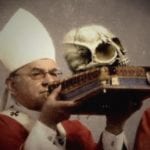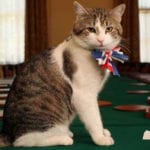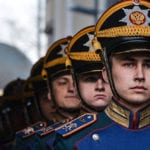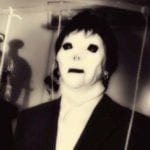 Mysteries
Mysteries  Mysteries
Mysteries  Creepy
Creepy 10 Scary Tales from the Middle Ages That’ll Keep You up at Night
 Humans
Humans 10 One-of-a-kind People the World Said Goodbye to in July 2024
 Movies and TV
Movies and TV 10 Holiday Movies Released at Odd Times of the Year
 Politics
Politics 10 Countries Where Religion and Politics Are Inseparable
 Weird Stuff
Weird Stuff 10 Freaky Times When Famous Body Parts Were Stolen
 Miscellaneous
Miscellaneous 10 Interesting Things Manufacturers Stopped Making and Why
 Gaming
Gaming 10 Funny Tutorials in Games
 History
History 10 Fascinating Little-Known Events in Mexican History
 Facts
Facts 10 Things You May Not Know about the Statue of Liberty
 Mysteries
Mysteries 10 Devastating Missing Child Cases That Remain Unsolved
 Creepy
Creepy 10 Scary Tales from the Middle Ages That’ll Keep You up at Night
 Humans
Humans 10 One-of-a-kind People the World Said Goodbye to in July 2024
Who's Behind Listverse?

Jamie Frater
Head Editor
Jamie founded Listverse due to an insatiable desire to share fascinating, obscure, and bizarre facts. He has been a guest speaker on numerous national radio and television stations and is a five time published author.
More About Us Movies and TV
Movies and TV 10 Holiday Movies Released at Odd Times of the Year
 Politics
Politics 10 Countries Where Religion and Politics Are Inseparable
 Weird Stuff
Weird Stuff 10 Freaky Times When Famous Body Parts Were Stolen
 Miscellaneous
Miscellaneous 10 Interesting Things Manufacturers Stopped Making and Why
 Gaming
Gaming 10 Funny Tutorials in Games
 History
History 10 Fascinating Little-Known Events in Mexican History
 Facts
Facts 10 Things You May Not Know about the Statue of Liberty
10 of the Weirdest Things Held in Libraries and Archives
When people think of libraries and archives, their minds tend to go to books. Libraries are usually set up for everyday book lending, while archives typically store documents of historical importance. But lurking in some of these bookish buildings are also a number of far more bizarre objects. Here are 10 of the weirdest things that can be found in libraries and archives across the world.
Related: Top 10 Stolen Artifacts Displayed In Museums
10 A Preserved Mole
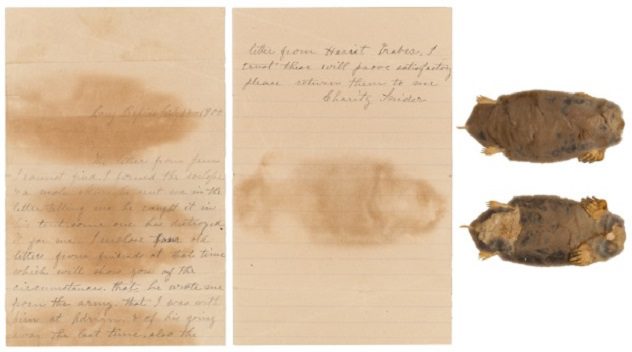
The National Archives and Records Administration (NARA) is home to many of America’s most important documents, including the Declaration of Independence, the Constitution, and the Bill of Rights. But it’s also home to the preserved skin of a mole. The small mammal was discovered in 2005 by a member of staff going through the Civil War Widows Certificate Approved Pension Case Files.
The subterranean creature found its way into the tent of Union soldier James J. Van Liew, who (for some unknown reason) captured it and sent its skin along with a letter to his “Dear Wife,” Charity Snider. Years later, in 1900, Charity found herself needing to prove that she was married to James in order to claim her Civil War widow’s pension, but she had no official documents (records were less consistent in those days).
While Charity had lost the letter that titled her “Wife,” she had shown it, along with the enclosed mole skin (which, for some reason, she held onto) to her friends. They were willing to attest to seeing the letter, and Charity sent the mole skin to the authorities as proof. Whether or not the mole helped her case is unknown, but she was granted the pension.[1]
9 A Book Made of Cheese
Ben Denzer’s 20 Slices was created to question the definition of a book. Within its traditional hardback cover are housed not paper pages with inked words but 20 slices of Kraft cheese. Although this art project is unreadable beyond the few words on the cover, it is officially counted as a book. Currently, six libraries own a copy, including the University of Oxford.
Tufts University Library in Massachusetts also owns a copy, and Darin Murphy, head of the library’s fine arts branch, reports that the book is a conversation starter among students. “They’re like, ‘What? You spent my tuition money on cheese? How much did you pay for it?’” says Murphy. “It’s a great teaching tool because it is so provocative.” Although the plastic-wrapped cheese pages will last for a long time, they will break down far faster than paper pages, so there is limited time to see the edible book.[2]
8 The Hair of Notable Historical Figures
It’s not uncommon for loose strands of human hair to wind up in books, but a few archives go a step further: they have specially preserved locks of hair from notable figures throughout history. For instance, the British Library in London holds a manuscript that contains a decorative lining showcasing hair from Mary Shelley, the author of Frankenstein (1818), and her poet husband, Percy Bysshe Shelley.
The Folger Shakespeare Library in Washington has a bracelet made of Edwin Booth’s hair. Booth was a Shakespearean actor whose achievements were overshadowed by his younger brother, John Wilkes Booth, who assassinated Abraham Lincoln.
A lock of George Washington’s hair was found in an envelope in an almanac in the Schaffer Library at Union College in New York. The book belonged to Philip Schuyler, and the envelope noted that it was “from James A. Hamilton given him by his mother, Aug. 10, 1871.” James was the son of Alexander Hamilton, and the family had probably been given the hair as a keepsake, as was common in that era. Although it has not been DNA tested, it is believed to be genuine.[3]
7 Death Masks
State Library Victoria in Melbourne, Australia, has a small collection of death masks, which are plaster casts made of a person’s face after death. Their most famous death mask is that of Ned Kelly, the notorious bushranger and outlaw. The mask was made shortly after Kelly was hanged on November 11, 1880, and then put on public display. It indulged the public’s fascination with Kelly and served as a deterrent to other criminals. The mask was also studied to see if the bumps of his skull corresponded to criminal tendencies; this is known as phrenology and is now discredited as a pseudoscience.
Other libraries around the world also hold death masks. New York Public Library, for instance, has those of the poets E. E. Cummings and James Merrill.[4]
6 A Spirit Trumpet
Many of the items stored at Cambridge University Library in England are, as would be expected, made of paper, but one particularly odd item is a cardboard spirit trumpet. Created for use during séances, a spirit trumpet would be placed on a table and then allegedly rise into the air and emit spirit voices and ectoplasm.
Cambridge University Library’s spirit trumpet was made in the 1920s by The Two Worlds Publishing Co. Ltd of Manchester. It is part of the Society for Psychical Research archive, which also holds a photo of ectoplasm (which is, of course, fake) that was captured during a séance conducted by medium Helen Duncan. In 1944, Duncan was one of the last people to be convicted under the Witchcraft Act of 1735.[5]
5 A Booklet Encased in Concrete
Books are usually made to be read, but Wolf Vostell’s Betonbuch (Concrete Book) purposefully defies readers. Vostell created 100 copies of his concrete book in 1971. Copy 83 of this impenetrable book is held in the University of Chicago’s library. Within the concrete is supposedly a 26-page pamphlet titled “Betonierungen” (“Concretifications”), which outlines his other concrete art projects, some realized and some impossible to realize.
“He wanted to concretify the city of West Berlin. He wanted to concretify clouds,” explains Patti Gibbons, Head of Collection Management at the Hanna Holborn Gray Special Collections Research Center, who has read the loose copy of the pamphlet owned by the library. However, Vostell was known for having a sense of humor, so there may be something completely different entombed within the concrete or even nothing at all. Despite various attempts to noninvasively probe the concrete, scientists have so far been unable to determine what lies inside.[6]
4 An Elephant’s Tail
The most requested item at Tufts Digital Collections and Archive is an elephant’s tail. Specifically, it’s the tail of a circus elephant named Jumbo, whose stuffed hide was donated to the university by P. T. Barnum, a founding trustee of Tufts. Jumbo, who stood 11- feet (3.4 meters) tall and weighed 5 tons (4.5 tonnes), became the mascot of the university, hence present-day students wishing to see his tail (the only remaining part of the elephant).
Back when Jumbo was still whole, Tufts students “tugged his tail and put pennies in his trunk for luck,” but eventually, his tail was accidentally pulled off. That accident is the only reason that any of Jumbo still exists, though. While the tail was stored in the university archives, the rest of the body was burned in the 1975 Barnum Hall fire.
Although Jumbo’s tail is the only whole body part remaining, someone from the Athletics Department scooped some of his ashes into a peanut butter jar. This is now used in a ceremonial “passing of the ashes” whenever a new athletics director is hired.[7]
3 Jack Kerouac’s Blood
Beat Generation author Jack Kerouac is best remembered for writing On the Road (1957), but before penning this iconic novel, Kerouac made an unusual pledge to his aspirational literary career. While living with his parents in Queens, New York, Kerouac wrote “The Blood of the Poet,” in reference to the 1930 Jean Cocteau film, on an index card and then cut his finger to write “BLOOD” in blood on the card, which he then hung above his desk.
Kerouac supposedly performed this odd act “as a notice of his vocation.” He also wrote “Blood-stained string used as tourniquet for finger, Nov. 10, 1944” on the card. The bloody card, still attached to the string it was hung from, now resides at New York Public Library in the Berg Collection.
This bloody act wasn’t just a one-off either; Kerouac also wrote “BLOOD” on the first leaf of the still-unpublished novella I Bid You Love Me, later retitled as Galloway.[8]
2 Charles Dickens’s Cat Paw Paper Knife
Another strange item in NYPL’s Berg Collection is an ivory paper knife with a handle made from a cat’s paw. The strange knife was owned by Charles Dickens, author of many classic Victorian novels, including A Christmas Carol (1843). The top of the blade, near the cat paw hilt, is engraved “C.D. in memory of Bob 1862.” Bob, of course, being his dearly departed cat.
His daughter Mamie said that Bob would follow her father “about the garden like a dog and sit with him while he wrote.” This affection clearly went both ways because when Bob died, Dickens had the paw stuffed and attached to the blade as decoration. During the Victorian era, pet taxidermy wasn’t all that odd or unusual, but affixing a stuffed paw onto a knife definitely was.[9]
1 KKK Robes
Cushing Memorial Library & Archives at Texas A&M University houses Ku Klux Klan robes and hoods embroidered with the names of people connected to the university. One of the standout names is that of football player Dana X. Bible, who was the head football coach of the university in 1917 and then again from 1919–1928. He also served as the head basketball for most of this time and had a brief stint as the baseball coach.
The university’s yearbooks have also been digitized, allowing the public access to pictures of students and staff wearing KKK robes, along with racist caricatures. David Carlson, the dean of the library, explains that they refuse to hide the university’s historical connection to racism: “Mistakes of the past, even though they may be mistakes, they’re mistakes that we can learn from. If we hide them, we never learn from them.”[10]
